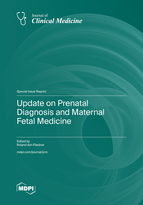Update on Prenatal Diagnosis and Maternal Fetal Medicine
A special issue of Journal of Clinical Medicine (ISSN 2077-0383). This special issue belongs to the section "Obstetrics & Gynecology".
Deadline for manuscript submissions: closed (25 May 2023) | Viewed by 51652
Special Issue Editor
Interests: fetal echocardiography; detailed anomaly scan; first trimester screening; genetic testing; fetal therapy; advanced imaging modalities
Special Issues, Collections and Topics in MDPI journals
Special Issue Information
Dear Colleagues,
The area of prenatal diagnosis and therapy and the field of maternofetal medicine are rapidly evolving. With the advent of new imaging modalities, sophisticated laboratory methodology and fetal treatment options, knowledge and parental counselling has to keep up with it. In this Special Issue, we aim to provide an overview of what the latest achievements in the field are. The spectrum of topics ranges from fetal diagnosis and therapy of abnormalities to genetic testing modalities and maternofetal medicine.
Prof. Dr. Roland Axt-Fliedner
Guest Editor
Manuscript Submission Information
Manuscripts should be submitted online at www.mdpi.com by registering and logging in to this website. Once you are registered, click here to go to the submission form. Manuscripts can be submitted until the deadline. All submissions that pass pre-check are peer-reviewed. Accepted papers will be published continuously in the journal (as soon as accepted) and will be listed together on the special issue website. Research articles, review articles as well as short communications are invited. For planned papers, a title and short abstract (about 100 words) can be sent to the Editorial Office for announcement on this website.
Submitted manuscripts should not have been published previously, nor be under consideration for publication elsewhere (except conference proceedings papers). All manuscripts are thoroughly refereed through a single-blind peer-review process. A guide for authors and other relevant information for submission of manuscripts is available on the Instructions for Authors page. Journal of Clinical Medicine is an international peer-reviewed open access semimonthly journal published by MDPI.
Please visit the Instructions for Authors page before submitting a manuscript. The Article Processing Charge (APC) for publication in this open access journal is 2600 CHF (Swiss Francs). Submitted papers should be well formatted and use good English. Authors may use MDPI's English editing service prior to publication or during author revisions.
Keywords
- fetal echocardiography
- fetal abnormalities
- fetal therapy
- genetic testing







